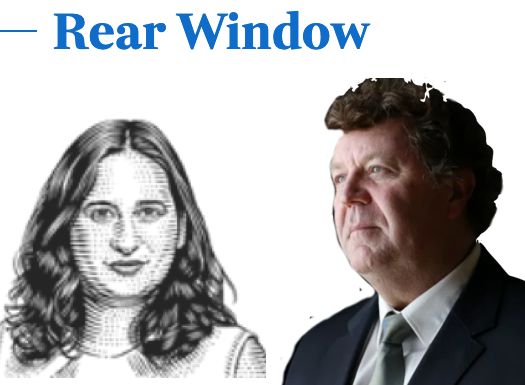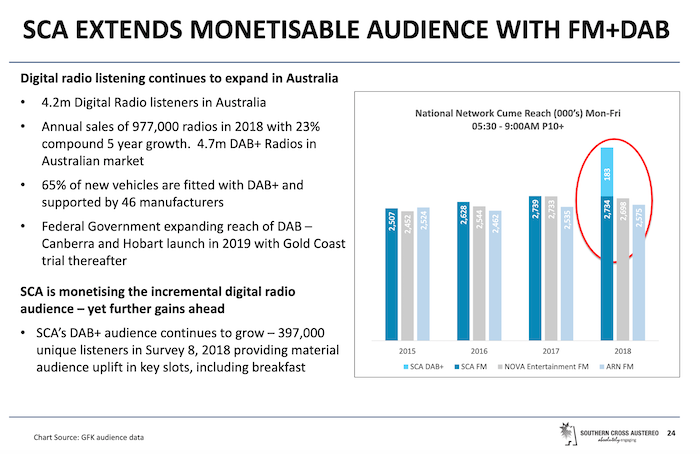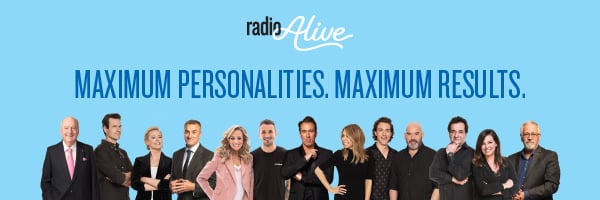An article published in today’s Australian Financial Review is “completely inaccurate” according to SCA’s Grant Blackley.
The article comments on Southern Cross Media’s half yearly report, criticising a graph showing comparative total metro network listening across the various commercial networks.
The article, written by Myriam Robin, says: “At Southern Cross Austereo, its half-year results feature a graph that could (and from what we hear, has) mislead investors into thinking it has far more listeners relative to its rivals than it really does.”
Grant Blackley has told radioinfo this morning: “Her source has misled her, that is completely inaccurate, we are using legitimate approved figures that reflect the way we have reorganised our brands.”
The numbers in the half year report reflect the way that SCA has aggregated its brands across the analog and digital platforms, and they are advertiser focussed, according to Blackley.
“If you buy ads on the Hit network, a client will have their advertisements heard on all our metro hit stations, on FM frequencies and on digital radio. Your ad will be played on Buddah as well as Hit FM… you will get five spots across all the Hit network stations. Our graph reflects that reality for advertisers.
“An advertiser that buys 100 units on Nova or KIIS will get 100 units, if that advertiser buys 100 units on our Hit or Triple M networks they will get 108.4 units for their money. Our digital stations give us an additional 397,000 unduplicated listeners nationally, and we are reflecting that in our figures… we are reflecting the way that advertisers can buy our audience.”
Commenting on his rvials, Blackley says Nova Entertainment declined to buy additonal DAB+ bandwidth when the opportunity was offered years ago. ARN does have additional bandwidth, but uses a different strategy for its digital stations according to Blackley: “ARN have subleased their spectrum to an intenational company, iHeart Radio, they sell their advertising differently.”
The AFR article said: “In purporting to show the relative cumulative reaches of SCA stations at Breakfast (5.30am to 9am) compared to those of major FM rivals Nova and Australian Radio Network, SCA adds the DAB+ figures to its totals. And has handily drawn a red circle around its outstanding performance for emphasis. But for Nova and ARN, it shows only their traditional FM listeners, despite both also having DAB+ listeners. That, dear readers, is textbook apples and oranges.”
Blackley flatly rejects that claim. “It IS apples with apples, we are comparing audiences and advertiser value.”
He believes one of his rivals deliberately misled the AFR reporter about the figures.
“We have been pursuing this strategy consistently for two years and it is benefitting our advertisers, the graph in the report accurately reflects that listener-focused strategy.
“Some of our rivals need to wake up, the world and the technology has changed.”
While this current issue may be causing some friction between rival networks, the entire industry is generally supportive of both DAB+ and digital delivery via online, apps and streaming.
radioinfo reached out to the other networks for comment, and ARN’s CEO Ciaran Davis responded:
“It’s important for the entire industry that all audience numbers are consistently and accurately represented, and for any network to exclude like-for-like DAB+ numbers for all operators in comparison reports is misleading – period.
“With regards to how ARN offer advertising via DAB+, we do monetise our DAB+ audiences – organically and as part of bundled packages.”



